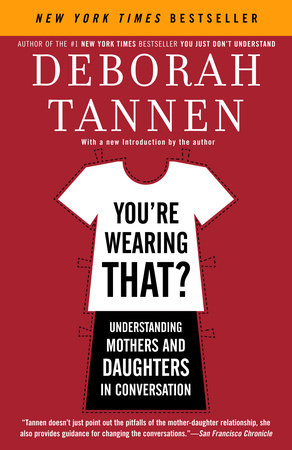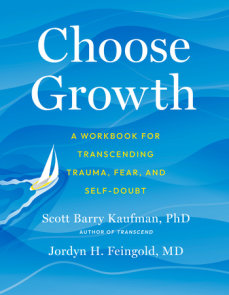READERS GUIDE
Questions and Topics for Discussion
1. According to Tannen, talk between mothers and daughters can be the best and worst of all possible conversations; we talk to our daughters and mothers in better and worse ways than we talk to anyone else. What are some of the best aspects of mother-daughter conversations? What are some of the worst?
2. In a chapter entitled “My Mother, My Hair,” Tannen calls hair, clothes, and weight the Big Three that mothers and daughters critique in each other. Why, according to Tannen, do girls and women tend to criticize their mothers and daughters on these aspects of appearance? Can you think of other reasons? What other characteristics are also frequent topics of comments that come across as criticism?
3. How could a comment like “Do you like your hair that long?” be interpreted as criticism? How could it not? What other comments that are not critical on the surface have you heard and interpreted as criticism? What do these comments have in common?
4. Look around the room and consider the range of hairstyles you observe among the women and, in contrast, the men. Ask yourself how many of these hairstyles you think are the most flattering possible–but keep your observations to yourself! Then ask (again, privately) what impression you get of the character or lifestyle of each individual, based on hairstyle, or choice of clothes. Do you draw as many conclusions about men as about women based on these style choices? Does this play a role in women’s tendency to critique their daughters’ or mothers’ appearance?
5. Tannen claims that the mother-daughter relationship is especially intense and complex because both are women. How does the role of talk in relationships tend to differ for women and men? How does this affect mothers and daughters? (You may want to refer to Tannen’s earlier book You Just Don’t Understand for a discussion of how women and men use language.)
6. An aspect of girls’ and women’s friendships is “troubles talk.” Why does troubles talk present a special challenge for mothers and daughters? How would a friend be likely to respond when you tell about a problem? How would a mother be likely to respond? How would you be likely to react to those responses?
7. Another aspect of girls’ and women’s friendships is the focus on sameness. If you have daughters, have you observed this in their friendships or experienced this with regard to yourself or other family members? Do you sometimes think about ways you and your mother or daughter are the same or different? Does this bring you closer or create distance? Does it affect how you, or your mother or daughter, think about your own life? How do you think your mother or daughter feels, or felt, about similarities or differences between you?
8. Girls at play often punish a girl they don’t like by locking her out (“You can’t come to my birthday”), and women are often sensitive to being excluded as well. How does feeling left out often cause pain for mothers of adult daughters? How can either the mother or the daughter address this discomfort?
9. How often do you think it is appropriate for a mother and daughter to talk on the phone, visit, or exchange e-mails? What happens when a mother and daughter–or sisters and brothers– have different ideas about what amount of contact is desirable, appropriate, or healthy?
10. Tannen points out that women often expect more of daughters than sons, and of mothers than fathers. Can you think of examples when you observed or experienced this? Why would this be so? What are some of the advantages and disadvantages of these greater expectations? Can anything be done to change this–and should it be changed? Do you think this pattern is avoidable, inescapable, or even preferable?
11. Tannen points out many ways that a woman’s relationship with her mother changes when she has children of her own. For example, sharing interest in the (grand)children can bring them closer, but if the (grand)mother criticizes the (grand)children, their mother may hold back on talking about them, and the criticism may remind her of how she herself was criticized or not accepted by her mother. All mothers worry that they are not good enough mothers, so criticism of how a woman is raising her children proves especially troubling to the woman criticized. Have you noticed other ways that having children affects a woman’s relationship with her mother? Are there positive or negative effects that Tannen did not note?
12. Many women told Tannen that they sense their daughters’ or their mothers’ moods instantly and often absorb that mood. How strong is the experience of such a transfer of emotions? Are there other ways that a mother can be a lightning rod in the storm of family emotions? Why do daughters sometimes express anger more freely at mothers than fathers?
13. In a chapter entitled “Oh Mom . . . brb,” Tannen discusses how e-mail and Instant Messaging can change mother/daughter relationships. Did you recognize the meaning of “brb”? Do you routinely use e-mail, IM, or text messaging? How do these means of communication differ from telephones, letters, and face-toface conversation? Have you used these new media with your mother or daughter? How has this affected your relationship?
14. In a chapter entitled “Wanted: Mother, A Job Description,” Tannen lists many requirements of the job of mother, and notes that it’s impossible for any one person to fulfill them all. What are the job requirements she lists? Can you think of others? Are some of them contradictory?
15. One woman said, “My relationship with my mother keeps changing; she’s been dead twenty years.” The mother-daughter relationship lasts a lifetime, including after the mother’s death. Tannen gives examples of women who felt their mothers’ influence was positive, and some who felt it was negative, after they were gone. If your mother has passed on, what are some ways that you still have a relationship with her? If she is still alive, how do you think your relationship may evolve after she’s gone?
16. What is “complementary schismogenesis”? Have you ever experienced such a mutually aggravating spiral? You might note, when an argument breaks out, what each person said, and how each offending comment might have been triggered by the one that came before it. You might even tape-record conversations in order to catch the one that ends in an argument, so you can go back and see where things went awry. Then ask, what could you have said differently to change the response and therefore the outcome?
17. A lot of what we hear focuses on the positive side of mothering, especially around Mother’s Day. Tannen discusses these aspects, but she also discusses the dark side: ways that mothers can cause their daughters pain, undercut their confidence, clip their wings, even physically beat them. Abuse can also flow from daughter to mother, especially if the mother is old or dependent. How prevalent, in your experience, is this dark side? How often is it talked about? Can the positive and negative co-exist in the same other-daughter pair?
18. Tannen makes many suggestions for improving mother-daughter conversations, and hence relationships. Among them are: Adopt the mantra “Don’t advise, don’t criticize”; offer praise; reframe criticism as caring; if talk leads to arguments, talk differently (tell jokes; change topics); spend less time talking and more time doing things together; use humor. Are these suggestions realistic? Can you think of others that you have used or would like to try?
19. Tannen points out that much of what she says about mothers and daughters may also be true of mothers and sons, fathers and daughters, or fathers and sons. Describe some ways that you have observed or experienced similar phenomena in these other relationships. Are they as widespread, frequent, and intense in these other relationships? If so, how? If not, why not?
20. Many women told Tannen that they have better communication, and better relationships, with their daughters than they had with their mothers. Why do you think this is? Is this cause for hope? What other causes for hope can you think of?






















